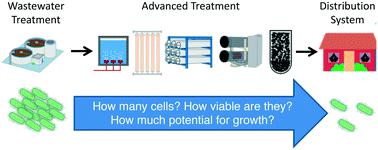当前位置:
X-MOL 学术
›
Environ. Sci.: Water Res. Technol.
›
论文详情
Our official English website, www.x-mol.net, welcomes your
feedback! (Note: you will need to create a separate account there.)
Removal and growth of microorganisms across treatment and simulated distribution at a pilot-scale direct potable reuse facility
Environmental Science: Water Research & Technology ( IF 3.5 ) Pub Date : 2020-03-10 , DOI: 10.1039/c9ew01087d Scott E. Miller 1, 2, 3, 4, 5 , Roberto A. Rodriguez 5, 6, 7 , Kara L. Nelson 1, 2, 3, 4, 5
Environmental Science: Water Research & Technology ( IF 3.5 ) Pub Date : 2020-03-10 , DOI: 10.1039/c9ew01087d Scott E. Miller 1, 2, 3, 4, 5 , Roberto A. Rodriguez 5, 6, 7 , Kara L. Nelson 1, 2, 3, 4, 5
Affiliation

|
Multi-barrier advanced treatment trains have been shown to purify wastewater to drinking water standards, but improved methods are needed to better understand microbial concentrations, viability, and growth potential throughout treatment and distribution systems. In this study, bulk water cell counts, adenosine triphosphate concentrations, and assimilable organic carbon were measured throughout a pilot-scale direct potable reuse facility and three parallel chlorinated simulated distribution systems fed with the pilot's finished water. We also investigated the impacts of treatment operations (e.g., membrane cleanings) and perturbations (e.g., incomplete wastewater nitrification) on microbial water quality. Intact cell counts and total adenosine triphosphate concentrations were reduced to near or below method quantification limits (22 cells per mL and 10−4 nM, respectively) by reverse osmosis and advanced oxidation. Total cell counts and assimilable organic carbon concentrations were consistently above method quantification limits (12 cells per mL and 10 μg L−1, respectively) in finished water (i.e., granular activated carbon filtrate). However, assimilable organic carbon levels in finished water were lower than values typically measured in conventional drinking water systems in the United States, and cell counts were dramatically reduced by batch chlorination. Occasional ammonia passage through advanced treatment caused large variations in chlorine demand in finished water, and a strong inverse correlation was observed between cell counts and residual free chlorine in the simulated distribution systems. We show that multi-barrier advanced treatment reliably rejects wastewater-derived bacterial cells, and that the methods applied herein can provide complementary information to traditional monitoring approaches to evaluate microbial water quality throughout treatment and distribution.
中文翻译:

在中试规模的直接饮用水再利用设施中通过处理和模拟分配来去除和生长微生物
已经显示出多屏障高级处理系统可以将废水净化到饮用水标准,但是需要更好的方法来更好地了解整个处理和分配系统中的微生物浓度,生存能力和增长潜力。在这项研究中,整个试点规模的直接饮用水再利用设施和三个由试点成品水供料的平行氯化模拟分配系统均测量了大块水细胞计数,三磷酸腺苷浓度和可吸收有机碳。我们还研究了处理操作(例如膜清洁)和扰动(例如,废水硝化不完全)对微生物水质的影响。通过反渗透和高级氧化,完整细胞计数和三磷酸腺苷总浓度降低至接近或低于方法定量限(分别为22个细胞/ mL和10 -4 nM)。总细胞计数和同化有机碳浓度始终上述方法定量(每毫升12个细胞和10μg大号限制-1成品水分别)(即,颗粒状活性炭滤液)。但是,最终水中的可吸收有机碳含量低于美国常规饮用水系统中通常测量的值,并且通过分批氯化处理大大减少了细胞计数。偶尔经过高级处理的氨会导致最终水中的氯需求量发生很大变化,并且在模拟的分配系统中观察到细胞数与残留游离氯之间存在强烈的反相关性。我们表明,多屏障高级处理可靠地拒绝了废水来源的细菌细胞,并且本文中应用的方法可以为传统的监测方法提供补充信息,以评估整个处理和分配过程中微生物的水质。
更新日期:2020-03-10
中文翻译:

在中试规模的直接饮用水再利用设施中通过处理和模拟分配来去除和生长微生物
已经显示出多屏障高级处理系统可以将废水净化到饮用水标准,但是需要更好的方法来更好地了解整个处理和分配系统中的微生物浓度,生存能力和增长潜力。在这项研究中,整个试点规模的直接饮用水再利用设施和三个由试点成品水供料的平行氯化模拟分配系统均测量了大块水细胞计数,三磷酸腺苷浓度和可吸收有机碳。我们还研究了处理操作(例如膜清洁)和扰动(例如,废水硝化不完全)对微生物水质的影响。通过反渗透和高级氧化,完整细胞计数和三磷酸腺苷总浓度降低至接近或低于方法定量限(分别为22个细胞/ mL和10 -4 nM)。总细胞计数和同化有机碳浓度始终上述方法定量(每毫升12个细胞和10μg大号限制-1成品水分别)(即,颗粒状活性炭滤液)。但是,最终水中的可吸收有机碳含量低于美国常规饮用水系统中通常测量的值,并且通过分批氯化处理大大减少了细胞计数。偶尔经过高级处理的氨会导致最终水中的氯需求量发生很大变化,并且在模拟的分配系统中观察到细胞数与残留游离氯之间存在强烈的反相关性。我们表明,多屏障高级处理可靠地拒绝了废水来源的细菌细胞,并且本文中应用的方法可以为传统的监测方法提供补充信息,以评估整个处理和分配过程中微生物的水质。











































 京公网安备 11010802027423号
京公网安备 11010802027423号